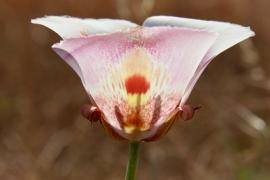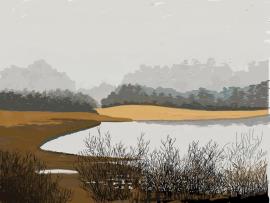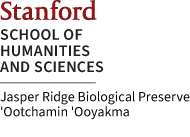Oakmead Herbarium and Collections
⇒ Jasper Ridge in Jan, Feb, Mar, Apr, May, Jun
Jul, Aug, Sep, Oct, Nov, Dec
Annual Report & Floral Postcards
Willow Forest | Mapping Preserve Willows | Fine Scale Veg Map
Curation and fieldwork & Herbarium affiliates
Calflora Great Places | iNat
The Biomass Distribution on Earth | Science Editorial Collections are truly priceless
Vascular Plants | Bryophytes | Lichens | Fleshy Fungi
Plant photo favorites | Virtual tour with our photo archive
Fading wildflowers? Disappearances and declines
The Jasper Ridge Biological Preserve Oakmead Herbarium (JROH) conserves specimens of over 1,000 plants and lichens. The earliest vouchers date from the 1860s and were originally part of Volney Rattan's herbarium. Over the intervening 150 years numerous workers have cumulatively recorded 900 different vascular plants, 76 bryophytes, and 122 lichens. Since 2000, the herbarium group has accessioned nearly 1,000 specimens. There are, however, other and perhaps more significant measures of the richness of the Preserve's flora: Locally Rare and Uncommon plants.
Vascular plants in the herbarium represent over 10% of the terminal taxa (species, subspecies, varieties) native or naturalized in California, 440 genera in 103 families.* Specimen records are in the Consortium of California Herbaria.
Learn more about the Oakmead Herbarium Group.
- Vascular Plant List
- Phylogentic guide to Jasper Ridge Vascular Plant Families | Jepson eFlora Phylogenetic Index
- Jasper Ridge Biological Preserve Serpentine Flora
- JRBP Lycophytes & Ferns
- JRBP Poales E-Flora & Poales in Santa Cruz Mountains Bioregion
- Bioregion grass checklist by subfamily, tribe, genus
- C4 species at JRBP
- Plants of Searsville Lake and Wetlands South of Searsville Lake
- Jasper Ridge Global Change Experiment Plant List 2012
- Plants in the local flora with nitrogen-fixing symbionts
- Bryophyte Checklist | JRBP specimens at Cal Academy of Sciences
- Bryophytes Collected by Jim Shevock | Field characters of some bryophytes
- Artificial Key . . . Mosses . . . SF Bay Area (Steere)
- The Mosses of Stanford University and Vicinity
- Shevock, The amazing design of a moss leaf
Lichens, Fleshy Fungi, Plant Galls
- Preliminary Lichen Checklist, 2022
- Renshaw, D. Common Lichens of Jasper Ridge
- Doel, J. 1996. Key to the commoner lichens on Jasper Ridge | A Lichen Field Guide for Jasper Ridge
- Tucker, S. 2014. Catalog of Lichens, Lichenicoles and Allied Fungi in California. Includes links to photographs
- Photos of some Jasper Ridge lichens
- Tok, E. 2022. Make Your Own Herbarium: Guide to Macrofungi Collection | JRBP Fungi Collection: planning document
- Macrofungi Photos, iNat Fungi and Lichens
- Gallformers [Oak galls] | Cynipoidea at JRBP. Gall wasps and allies
Continuing Education
- Cheney, C. Introduction to JRBP Native Trees
- Corelli, T. Trifoliums of San Mateo and Santa Clara County
- Corelli, T. Woody Plants at Jasper Ridge
- Derrer, Teal. Notable Spring Wildflowers in the Serpentine Bunchgrass Grassland and adjacent Oak Woodlands. Photographs by Alice Cummings.
- Oakmead Herbarium. Plant photo favorites and Virtual tour
- Oakmead Herbarium. Plants in the local flora with nitrogen-fixing symbionts
- Oakmead Herbarium. Plant Family Characteristics
- Oakmead Herbarium. Selected Plant List by Family
- Rawlings and Renshaw. Simple Willow identification guide: leaf comparison and variation
- Renshaw, D. Common Lichens of Jasper Ridge
- Renshaw, D. Fall Trees and Shrubs of Jasper Ridge | Derrer, T. Trees + Shrubs Checklist
News
- Ward, N. 2024. The Potential of Herbarium Specimens in Capturing Historical Herbivory: A test of the consequences of global insect decline
- Floral Postcards | Palmer Oaks | Round-tooth Ookow | Allium | Piperia
- Floristic Statistics (2023): 830 native and naturalized vascular plant taxa, 443 genera and 103 families. Oakmead Herbarium also preserves 76 Bryophyte taxa and 122 lichens
- Disappearances and declines & Intervention ecology now?
- Weeds, including Herbarium weeding projects, Arrival dates of some naturalized grasses
- Jasper Ridge place names
Maps & Vegetation Surveys
- Special Status: Rare.kmz and Dirca.jpeg, Dirca.kml | Locally Rare (.kmz) | Watch List (.kmz)
- San Francisquito Creek Watershed Map
- Riparian: invasives (Acacia) and sensitive plants (Rare, Locally Rare, and Watch List maps listed above)
- Willow sampling in marsh and creeks
- Danthonia californica 2013 | Festuca californica 2016 | Lessingia hololeuca 2012
- Vegetation Map rev. 2016 (Affiliates)
- Geology Map (Affiliates)
- Sector Map Book (Affiliates)
- Herb Dengler Place Names + Google Earth version (Affiliates)
- Insolation Map (Weiss, 2000)
- William Cooper Transect
- Herb Dengler Vegetation Transect 1953 (Affiliates)
- Preserve Trails 1/1982 | 12/1988
- CNPS Rapid Vegetation Assessments | Vegetation Cover Estimate Diagrams
- Proposed Dam Sites on San Francisquito Creek. [Property of Leland Stanford in San Mateo and Santa Clara Counties.] Stanford University Special Collections and Archive. M009 os after 1885; [1883? - 1887?]
- Plat of Rancho Canada del Corte Madera, with overlay of Preserve boundary, 1879
- San Mateo Countywide Vegetation Assessment: Fine Scale Veg Map web portal; Preserve data sheets
- Santa Clara-Santa Cruz Countywide Vegetation Assessment, Data Portal: Project Update
- Map Archive Index (Affiliates)
Rare Plants and CNPS Rank
- Allium peninsulare Greene var. franciscanum McNeal & Ownbey [Rank 1B.2]
 Photo (rare, threatened, or endangered in CA and elsewhere; fairly threatened in California)
Photo (rare, threatened, or endangered in CA and elsewhere; fairly threatened in California) - Amsinckia lunaris J. F. Macbr. [Rank 1B.2]
 Photo (rare, threatened, or endangered in CA and elsewhere; fairly threatened in California). Calflora
Photo (rare, threatened, or endangered in CA and elsewhere; fairly threatened in California). Calflora - Arabis blepharophylla Hook. & Arn. [Rank 4.3]
 Photo (limited distribution; not very threatened in California)
Photo (limited distribution; not very threatened in California) - Dirca occidentalis A. Gray [Rank 1B.2]
 Photo (rare, threatened, or endangered in CA and elsewhere; fairly threatened in California)
Photo (rare, threatened, or endangered in CA and elsewhere; fairly threatened in California) - Eryngium jepsonii J.M. Coult. & Rose [Rank 1B.2]
 Photo (rare, threatened, or endangered in CA and elsewhere; fairly threatened in California). Calflora
Photo (rare, threatened, or endangered in CA and elsewhere; fairly threatened in California). Calflora - Lessingia hololeuca Greene [Rank 3]
 Photo (review list). 2012 Field Survey
Photo (review list). 2012 Field Survey - Lessingia tenuis (A. Gray) Coville [Rank 4.3
 Photo (limited distribution; not very threatened in California). Calflora.
Photo (limited distribution; not very threatened in California). Calflora. - Malacothamnus arcuatus var. arcuatus [Rank 1B.2]
 Photo (rare, threatened, or endangered in CA and elsewhere; fairly threatened in California). [Malacothamnus fasciculatus (Nutt. ex Torr. & A. Gray) Greene.] Calflora, iNaturalist
Photo (rare, threatened, or endangered in CA and elsewhere; fairly threatened in California). [Malacothamnus fasciculatus (Nutt. ex Torr. & A. Gray) Greene.] Calflora, iNaturalist - Monolopia gracilens A. Gray [Rank 1B.2]
 Photo (rare, threatened, or endangered in CA and elsewhere; fairly threatened in California)
Photo (rare, threatened, or endangered in CA and elsewhere; fairly threatened in California) - Piperia michaelii (Greene) Rydb. [Rank 4.2]
 Photo (limited distribution; fairly threatened in California)
Photo (limited distribution; fairly threatened in California) - Plagiobothrys chorisianus (Cham.) I.M. Johnst. var. hickmanii (Greene) I.M. Johnst. [Rank 4.2]
 Photo (limited distribution; fairly threatened in California)
Photo (limited distribution; fairly threatened in California) - Trifolium amoenum Greene [Rank 1B.1]
 Photo (rare, threatened, or endangered in CA and elsewhere; seriously threatened in California)
Photo (rare, threatened, or endangered in CA and elsewhere; seriously threatened in California)
Notes
* Native and non-native, naturalized vascular-plants known to occur—or have occurred (historical records are more than 25 years ago)—in the area of the Preserve. Almost all plants (98%) are documented by one or more herbarium vouchers in the Oakmead Herbarium or, occasionally, in other herbaria; without an herbarium voucher, the identification of a taxon may remain in doubt. In a very few cases, because of small occurrence size, a taxon is represented by digital photographs and/or a partial collection, e.g., single flower displaying diagnostic characters (DOC in the "document type" field). There are even fewer plants listed based solely on a report by qualified botanists (REP in the "document type" field). Some vouchered (garden and agricultural escapes) and most unvouchered reports are not included on the current Jasper Ridge Plant List. Springer 1935 and Moeur 1947 surveys lack vouchers; some entries are questionable. Porter 1962 & 1971 supplement is based on vouchered plants. Dengler's 1975 and 1984 lists comprising 600+ reports are supported by 115 sheets of >100 species; additional species are mentioned in his field notebooks. A few plants with vouchers could not be determined to species by staff; in some cases expert determination has been requested, often in vain.
Photographs ![]() Photo for most plants are linked to the Vascular Plant List entries. In addition to specimen labels and maps on many JROH specimen sheets, location, flowering time, and abundance records may also be found in Calflora. Historical observations from the Field Observations Database and the JRBP Poales E-Flora are being added to Calflora.
Photo for most plants are linked to the Vascular Plant List entries. In addition to specimen labels and maps on many JROH specimen sheets, location, flowering time, and abundance records may also be found in Calflora. Historical observations from the Field Observations Database and the JRBP Poales E-Flora are being added to Calflora.
Explore Vicky Z. Chan Oakmead Herbarium blog (click here for the virtual walk).
References relevant to the floristics of Jasper Ridge Biological Preserve. The history of the herbarium is described by Jewett (2005) Documenting Plant Diversity: Jasper Ridge's Herbarium. For Stanford's rich botany heritage see Timby (1998) The Dudley Herbarium: its origin, fate, and legacy at Stanford. Jasper Ridge grassland-related research is surveyed in Stromberg, M. et al. (2007) California Grasslands Ecology and Management and Lunch (2009) Primary production at Jasper Ridge Biological Preserve.
Credits: Calochortus argillosus Trail 15, Alice Cummings; Searsville Willow woodland, Anne Warren




